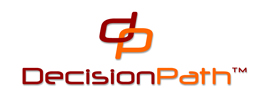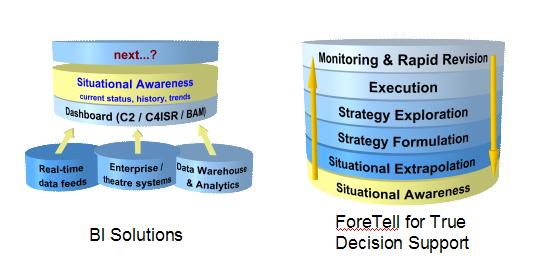True Decision Support
Business Intelligence is NOT Decision Support (contrary to marketing hype) True decision support tools actively enable or enhance decision-making processes. In contrast to conventional BI, ForeTell provides an explicit decision analysis methodology coupled with powerful simulation and analysis tools that directly target the crux of real world decisions: ForeTell helps you anticipate how your organization and key stakeholders will respond to your proposed actions and adapt to your proposed actions and changes in their environment. And while you execute your decisions, ForeTell helps you monitor your progress, identify problems, and adjust your actions as necessary. These capabilities represent true process-level support, not simply better inputs to a process where you have to do all the hard work. ForeTell Improves Decision Support Through Richer Modeling
Modeling software vendors also assert that their tools provides true decision support no less than ForeTell. In fact, these simulation products focus on one or two types of decision factors and dynamics, be it numbers and trends (spreadsheets); stocks and flows (system dynamics); statistical distributions (Monte Carlo); or relationships and adaptive behaviors (complex adaptive systems). Their methodologies focus on how to use particular tools to build (and test) models, not how to make decisions. By analogy, think of a camera that takes pictures of the world using a film that is only sensitive to one color, such as blue or orange. Or consider that the only tool available to you is a hammer, while you face a job that involves flat and Phillips-head screws, cotter pins, and rivets. If you can't model all key decision factors appropriately, you can't simulate their impact effectively. Using "one-trick" tools expose you to major risks of omission, bias, or distortion in your decision-making. To be realistic, models of complex decisions must capture and apply diverse form of static and dynamic situational knowledge. ForeTell's patent-pending framework captures quantitative, qualitative, and uncertain information in intuitive ways, via numbers, ranges, categories, lists, tables, relationships, and other objects. It unifies complementary simulation techniques to project the interacting dynamics of all of the different drivers of situational change - forces, trends, events, goal-driven behaviors, etc. Coupled with our scenario planning methodology, these "high fidelity" models map directly into your situations and your decision-making processes, providing you with true decision support. |
|

